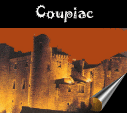 ORIGIN
ORIGINPREVIOUS HISTORY IN the X-TH CENTURY
 ORIGIN
ORIGIN
Coupiac's region was already lived at least at about 50 000 years before average paleolithic J.C. Du, the predatory moustériens hunters left us numerous vestiges of industry lithique collected in surface in our Sud-Aveyron. The department counts also a big density of megalithic graves and statues - menhirs. The discovery of a statue - menhir by the abbot Hermet, in Prade before 1901, as well as two others to Réganel, states a human activity(occupation) dating the from 2500 to 3000 years before J. C. on Coupiac.
The abbot Hermet, born in the Mas Capelier, near Saint-Izaire, was at the origin of the naming of statues - menhirs and their study. At present, these statues are to the museum of Saint-Germain-en-Laye's national Antiques; they are big boorishly cut and engraved stones, representing a person or a divinity, and raised(drawn up) in earth(ground); but their interpretation remains enigmatic.
In the region of Saint-Affricain, one lists(counts) about sixty it among whom(which) the exceptional "Lady de Saint-Sernin".
CELTIC AND ROMAN INVASIONS
At about the year 1000 before J. C., the South of the central Massif was gradually invaded by Celts, native of central Europe. These, merging with the local population, formed the Gallic people of the Ruthènes, conquered by Romans in 121 before J. C.
The marketing of sigillées potteries of Graufesenque in the Millau's close region, was most heavy industry of the Roman Empire. The mineralogical wealth of this country drew very early the attention of the men(people): iron was exploited(run) to Roquecezières, copper of the neighborhood of Monclar and Saint-Juéry, alum of the region of Saint-Sernin and sailing, stoneware of Molière near Sailing.
Coupiac stayed under Roman dominion until Ve century after J.C. Jules César, passing to Roquecezières, would have appreciated there the thrushes of Camarès.
WHERE FROM COMES COUPIAC'S NAME?
The gallo-Roman boss, who possessed Coupiac's region, made build his "villa" or rural domain near the cliff dominating in his environment(middle) the valley of the Froth(moss). It is much later, that on this cliff, was constructed a first castle. The name of this owner, or more credibly its nickname, is at the origin of Coupiac. He was called Cupidus in Latin, "that is greedy". By adding it the suffix " ac " (of " acum "), expressing the idea of property, one has Cupidiacum who abbreviated afterward in Copiacum and gave in language of oc Copiac, and in French " Coupiac ". Another interpretation makes divert Coupiac de Cupius sui comes from Cuppes meaning "gourmet", or Copied meaning abundance of wealth.
"BARBARIC" INVASIONS: VISIGOTHS AND FRANCS
"Barbarian" does not mean being cruel, uncultivated, or not civilized. Romans qualified as "barbarians" all the nearby peoples who did not participate in the Roman civilization. It is the case of the Visigoths or " western Goths ", by opposition to Ostrogoths or " east Goths ". Native of central Europe, they occupied the edges of the Adriatic. Romans, in full decline, confided(entrusted) the command of their army to a wisigoth general, Alaric. This one turned finally against Rome which it(he) seized in 410.
Hunted(chased away) by Italy by the famine, they came in Long pole, to Aquitaine. It explains their presence to Coupiac during hundred of year, 419 verses 507. Their establishment in the region is confirmed by the existence of two wisigoths cemeteries, the one on the tray(plateau) Saint-Laurent-Canivenq, of which it does not stay any more draw at present because put in culture, the other, discovered(found) in 1973, on a nipple in the South of Pailharié.
One loosened(kicked away) there a grave in good condition, with a skull inside. The big number of slates squared quite all around indicates that he should have there quite a lot of graves in this place. The Visigoths were Christian, but ariens. They did not admit the divinity of the Christ. That's why the bishops of Long pole supported heathen Clovis and his Francs, against the wisigoths heretics. These, beaten to Vouillé towards 507 by Francs, come from the northeast of the Germania, left the South of France and went to settle down in Spain. Henceforth, it is the Francs which occupy the Long pole. Through several centuries of inhumanity, the Long pole will become bit by bit the frank realm and France.